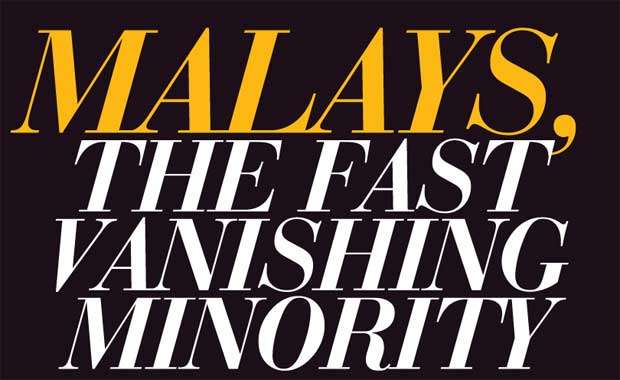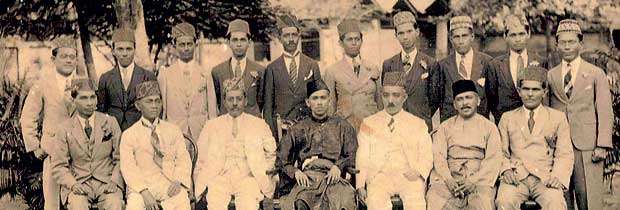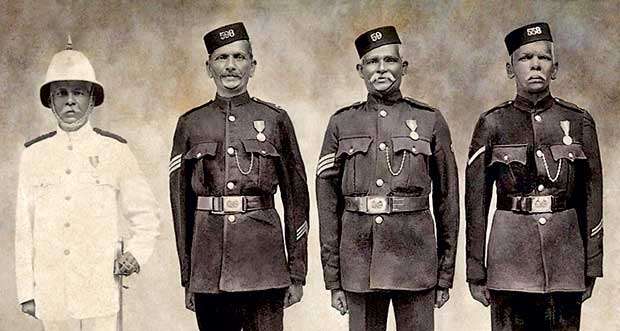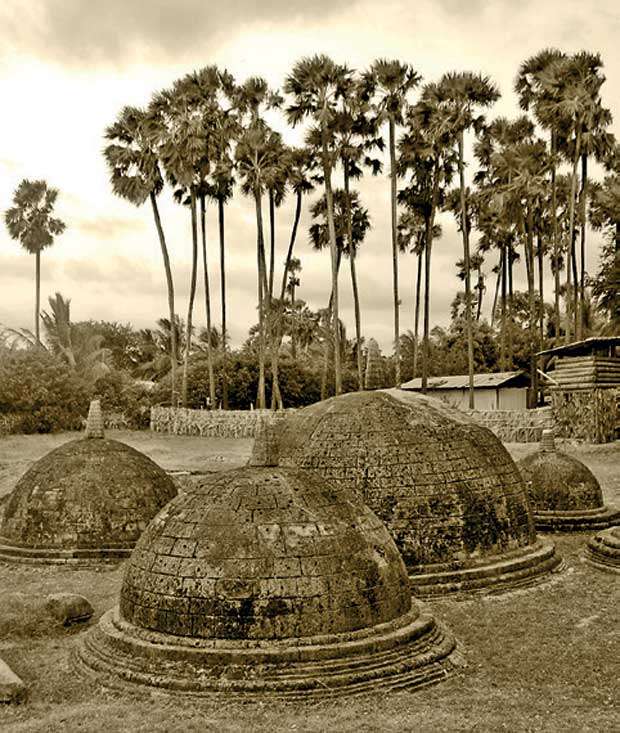04 Feb 2019 - {{hitsCtrl.values.hits}}

 he Ceylon Malay community which is rich in culture and religious traditions is an important ethnic minority that has played a major role in shaping the history and diversity of Sri Lanka.
he Ceylon Malay community which is rich in culture and religious traditions is an important ethnic minority that has played a major role in shaping the history and diversity of Sri Lanka.
However, Ceylon Malays have been facing a relentless demographic decline and their numbers have plummeted, falling by approximately 8 per cent a decade. Alas, there are only 40,000 Malays in Sri Lanka today and they comprise less than 0.18% of the country’s population. That fact itself is so alarming that it demands measures to help the community from fading away.
History has it that a large proportion of them came as mercenaries from the Indonesian Archipelago (then called Dutch East Indies) and Malayan Peninsula (former British Malaya) during the Dutch Colonial Era.
Some were exiled Royals, princes, their entourages, their retinue of servants, courtiers, and those of distinction, who were condemned to Ceylon, then a Dutch Colony as state prisoners.
The Dutch referred to them as ‘Oosterlingen’ meaning easterners as they hailed from Dutch East Indies. They belonged to different ethnic groups, tribes and castes and they spoke different languages and practised different religions including animism. In contrast to the past almost all Malays living in present day Sri Lanka are Muslims.
After the advent of the British Colonists, the easterners were identified as Malays, in spite of the fact that, most were not ethnic Malays by origin.
Because majority of them came from the Island of Java and were ethnic Javanese, the Malays are still known as “Ja Minussu” by the Sinhalese folks and as “Ja Manissar” by the Tamils and Moors.
"Though a small minority, Malays played a pivotal role in the security forces and bureaucracy of Colonial Ceylon"
Though a small minority, Malays played a pivotal role in the security forces and bureaucracy of Colonial Ceylon. The Dutch originally imported large numbers of Malay and Javanese lascarins for military service, mainly to fight the natives of the Island, to suppress the revolts against colonial rule and to protect economically important maritime forts from foreign incursions.
According to Lankan history, the Malays not only protected these impregnable fortresses but also built them.
The Island’s forts eventually became prisons for those who opposed colonial presence in Dutch East Indies and from 1700 onwards Malay/ Javanese Royals, aristocrats, their entourage of courtiers, retinues of servants and slaves were exiled to Ceylon.
In Colombo, the Malay/Indonesian exiles lived in Hulftsdorf in an area known as Kampung Pangeran or Princes’ quarters.After the advent of the British, the Malays joined the English troops and under the British rule, they became a ‘privileged minority’ who formed a socially exclusive intermediate stratum between the natives of the Island and the British/ Burgher elite.

They practically composed the well-known Ceylon Rifle Regiment (CRR) which became the first Asian Regiment in history to be bestowed with the prestigious King’s colours in 1802. After the disbandment of CRR in 1873, a great many of the Malay Riflemen joined the Police Force of which they became the most efficient members with their distinctive horsehair-like whiskers and moustaches.
During the last two centuries, the Malays in Ceylon have come to play a noteworthy role in the domain of economics, politics, science and the arts which is out of proportion to their negligibly small number. In 1947, Dr. T.B. Jayah was appointed as the Minister for Labour and Social Services and was the first Muslim Malay to be exalted to such an esteemed position. Dr M.P. Drahaman MBE, Senator M.K. Saldin, Baba Zahiere Lye and M.D. Kitchillan are examples of Malays who excelled in the political arena. The first non-Christian appointed to the Supreme Court bench in 1929 was a Malay Judge, Puisne Maas Thajon Akbar, who was responsible for the introduction of the first Muslim marriage, divorce and wakfs ordinance in Ceylon. Justice M. T. Akbar established the Crime Prevention Society in Ceylon and organised frequent meetings to address the issue of Narcotics in the Island. It is his family that built the Akbar Mosque, on Kew Road, Slave Island. Under the British rule, Malays were conferred with native titles and peerages, and they became an integral part of the administration of the island. Baba Hakim Muthaliph of Magampattuwa and Baba Thajon Arifin Doole of Hambanthota were appointed as Maha Wasala Mudaliars (Gate Mudaliyars). Mudaliyar Ahamath Ibrahim Jainu-Deen of Badulla, Mudaliyar Baba Junoor Haji Bahar and Muhandiram Tuan Kitchil Abu Cassim Burah are examples of other Malay feudal chiefs of British Ceylon. Even the famous De Seram family is of mixed Sinhala and Malay ancestry.
"There are only 40,000 Malays in Sri Lanka today and they comprise less than 0.18% of the country’s population"
In the field of theatre Malays were the pioneers. Tuan Ibhan Saladin Saldin, a Malay dramatist organized the first ever Sinhala Ballet “Vijaya and Kuveni” in 1936. Kalabushana Vernon Saldin, Kalavibhooshana Tuan Alaldeen Ibbon Saldin, Marquez H.H. Saldin, Gemini Kantha, Fareena Lye, Kalabushana Raheem Saheed and Kalabooshana Tuan Ruffin Saldin are other notable artists who have left an indelible mark on theatre history. Malay musicians also have a notable presence in the Lankan music scene in relation to the size of the community. Kalabooshana Stanley Oumar, G.S.B. (Gnei Seenar Bangsajayah) Rani Perera, Haroon Lanthra, Lakshmi Bhai, Umara and Umaria Sinhawansa are few notable examples.

The Malay community of Ceylon was most sports-conscious and pioneered many activities in a variety of sports in the Island especially the game of Cricket. In point of fact, Colombo Malay Cricket Club founded in 1872 is the oldest Cricket Club in Sri Lanka and in 1907, it became the first Ceylonese club to embark on a cricket tour overseas. In later years Malay club cricketers added finesse to their play and in 1920, Malays became Ceylon’s club champions in cricket. Former Captain of the National cricket team, Tillakaratne Dilshan (Tuan M. Dilshan), Baba Roshan Jurangpathy, Tuan Nishan Sampath, AC Amath, Allal Careem, T.K. Burah, A.A. Deane, Dr. A. Sourjah, Dr A.R. Deane and Sharmila Kitchill are some of the notable cricketers of Malay descent. Malay sporting zeal was not restricted to cricket alone.
Members of Malay Community are largely Muslims. The Colombo Grand Mosque and the Jawa Mosques located at Kirinda, Slave Island, Nanu Oya, Kalpitiya, Kandapola Wekanda, Bogambara, Kinniya, Jawatte, Alopotha, Bakinigahwela, Kurunegala, N’ Eliya, Badulla and other well known edifices were built and donated by the pious forefathers of the Malay community.
Even the Kandarodai Buddhist temple in Jaffna was built under the patronage of a Malay/ Javaka Buddhist Conqueror, Chandrabhanu the ruler of Tambralinga, a state in the Malay Peninsula.
When Malays came from the Indonesian Archipelago, they brought their drums, music and their dances, ancient ways their parents taught them, their culinary habits, literature and fashion.
When we speak about tantalizing delicacies of Malay Origin much of the Lankan food we know and love isn’t Lankan at all. Throughout the subcontinent’s history, new foods have been introduced through foreign invasions, trade and colonialism, creating the rich tapestry of cuisine we enjoy today. Wattalappan (sirkaya in Malaya), kokis (kembang goyang in Indonesia), bibikan (bikan cake in Indonesia), sambol, nasi goring, cina kue (introduced by the Peranakans), kavum (cucur), laveriya, dodol, the soft and spongy Idli and of course the Malay Pickle are of Malay/ Indonesian origin.
The age old Malay traditions, customs, rites and rituals might seem unusual, unique, or exotic to Sri Lankans. Unfortunately many Lankan Malays have abandoned their Malay customs and traditions, for the reason that Malay culture is based on Hinduism, Buddhism, animism and folk traditions. Islamisation is not about Arabisation, but what we are seeing in this country today is the process of Arabisation of the Malays mainly by Wahabis and other religious extremist groups. It is sad that most Malay youngsters do not speak Sri Lankan Malay language known as, “Bahasa Melayu Sri Lanka”, which is one of Asia’s most endangered languages and if it continues our nation will lose an irreplaceable treasure. Their numbers have dropped dramatically in the past few decades and it id evident that the future of Malays in Sri Lanka remains uncertain.

26 Dec 2024 8 minute ago
26 Dec 2024 1 hours ago
26 Dec 2024 2 hours ago
26 Dec 2024 4 hours ago
26 Dec 2024 5 hours ago